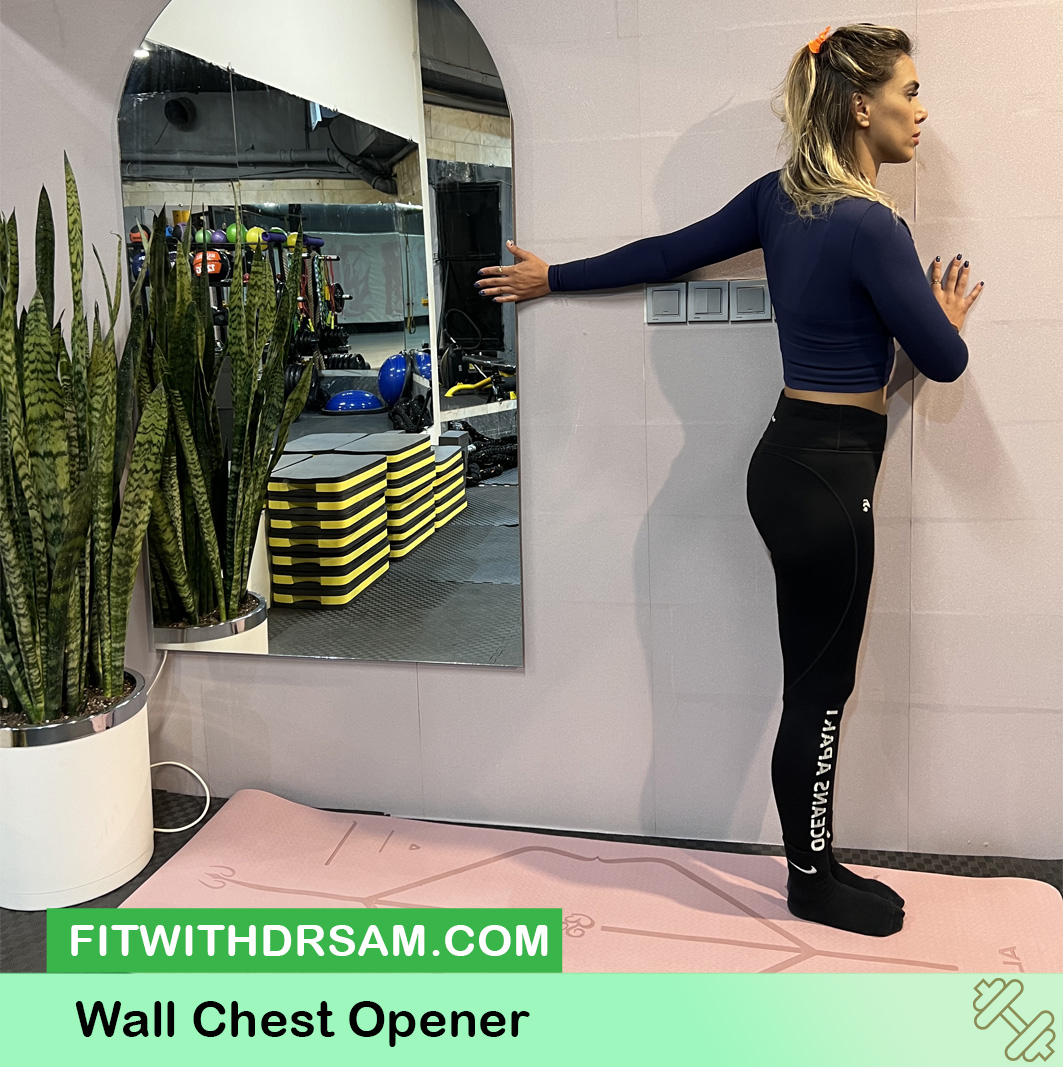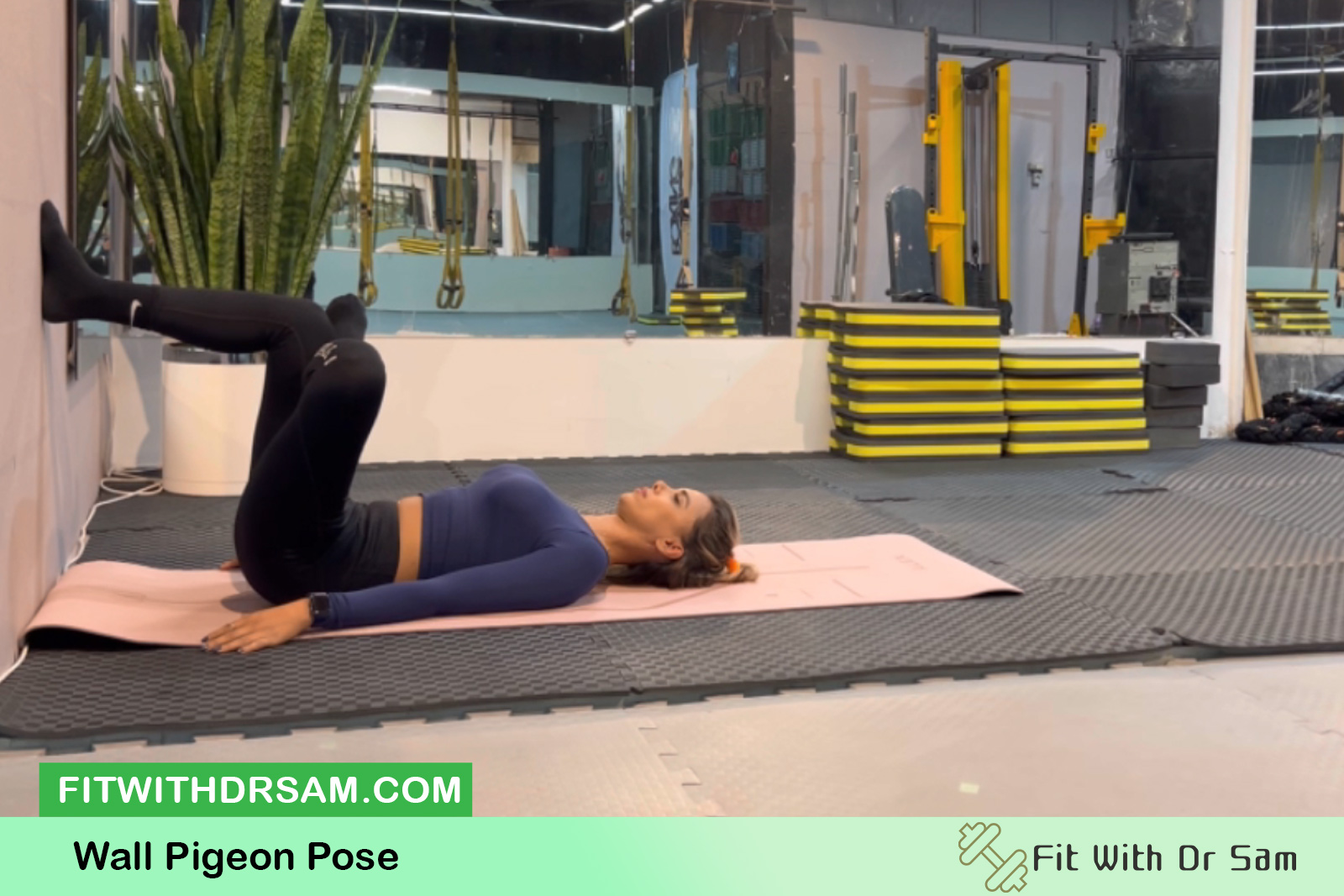Wall yoga poses for beginners
Here’s a 15-20 minutes wall yoga routine for beginners that you can easily add to your daily schedule. No matter how busy you are, these 20 minutes routine can help you relieve some stress, build strength and flexibility, correct your posture and keep fit.
- Warm-Up: Wall Downward Dog (Hold for 1 minute)
- Wall Warrior II (Hold each side for 30 seconds)
- Wall Chest Opener (Hold each side for 30 seconds)
- Wall Supported Chair Pose (Hold for 1 minute)
- Wall Pigeon Pose (Hold each side for 1 minute)
- Cool down: Wall Legs Up the Wall (Hold for 3-5 minutes): End your session with this calming pose. Lie down and swing your legs up the wall, letting the blood flow away from your legs and calming your nervous system.
You have probably never thought of your wall as a full-equipped gym! But what if you could turn a simple wall into the greatest workout tool possible? That’s exactly where wall yoga comes to shine. Whether you’re a complete yoga newbie or just looking to switch things up, wall yoga is the perfect way to ease into poses you never thought you could, with the greatest balance and support possible.
In this guide, we are going to walk you through everything you need to know to get started, from introducing basic wall yoga poses step by step to an easy-to-follow routine that will leave you feeling stronger and more flexible. So, to find out the answer to all your questions about how to do wall yoga and more, without further ado let’s get started.
You can also read: 12 Anti-Aging Yoga Poses for Wrinkles: Turning the Clock Backwards.
Table of Contents
Why wall yoga?
Many of you might doubt the effectiveness of wall yoga and think of it as a fleeting trend. So first let’s see if this method is worth the hype and whether you should give it a try or not.
Benefits of wall yoga are pretty much the same as yoga itself. However, in this method the wall acts as a stabilizer, giving you the confidence to hold positions longer and with better form. Plus, you don’t have to worry about falling out of balance or struggling to get your body into the right position. So, this method is actually a much better choice for beginners.
You can also read Wall Pilates Exercises for a Strong Core article, which is about wall movement.

According to international journal of yoga therapy, utilizing props, like walls, can enhance body alignment, reduce the risk of injury, and build muscle strength more effectively than traditional floor-based yoga alone [1].
Another benefit of wall yoga exercises is that they allow you to engage muscles that you may never be able to activate in regular workouts. Using wall as a steady leverage can help you access a deeper range of motion and develop flexibility without the pressure of doing it all unsupported. So, if you’ve ever felt too stiff or worried about trying yoga, wall yoga takes those fears off the mat!

Best beginner wall yoga poses
Now that we know all about the effectiveness of wall yoga for beginners let’s get into the exciting part! Here’s a list of beginner-friendly poses that you can easily practice at home. All of these exercises are designed in a way to be gentle, yet effective and very low-risk when it comes to injuries. By incorporating these wall yoga poses into your daily workout routine you can practice building strength and flexibility at the same time.
Wall Downward Dog
This pose is actually an amazing modification of the traditional Downward Dog. By using the wall in this exercise, you can gain a lot more support while still giving your spine and hamstrings a complete stretch.
How to do it?
- Stand facing the wall about two feet away.
- Place your hands shoulder-width apart against the wall.
- Step your feet back while lowering your torso, keeping your hands on the wall.
- Push your hips back and lengthen your spine. Try to keep the angle at 90-degrees
What are its benefits?
This yoga pose for beginners stretches the hamstrings, calves, and back while providing great shoulder strengthening without any wrist strain. Plus, the wall helps you maintain balance and proper form.

Wall-Assisted Warrior II
If you’ve ever tried performing warrior 2, you should already know that doing it on the mat is quite challenging. That’s where the wall comes to the rescue! You see, using the wall in this exercise helps you find stability and balance.
How to do it?
- Stand about a foot away from the wall and place your back against it.
- Step one foot forward into a lunge position, keeping your back foot turned slightly out.
- Bend your front knee while straightening your back leg. Make sure both of your feet are firmly pressed on the floor.
- Raise your arms, with your back body fully supported by the wall.
What are its benefits?
This move strengthens your legs and hips. More importantly, it is an exercise for the mind. Warrior II can help you enhance your focus and mental power.

Wall Chest Opener
This beginner wall yoga pose is amazing when you’re feeling tense after a long day at work. It helps you stretch out your chest, shoulders, and neck. Doing this simple pose works magically when it comes to releasing all the extra tension and improving posture.
How to do it?
- Stand sideways against the wall, about a foot away.
- Extend your arm back and place your palm flat on the wall.
- Gently twist your torso away from the wall until you feel a stretch across your chest and shoulder.
What are its benefits?
This pose opens the chest and shoulders. It is great for those who spend too much time hunched over a desk or have to sit down for long hours.

Wall Supported Chair Pose
This pose is amazing if you’re looking for exercises to get your core engaged. It also strengthens your legs. So, if you’re looking for building some strength and power this is a perfect choice.
How to do it?
- Lean your back against the wall.
- Slide down into a chair pose.
What are its benefits?
Chair pose is one of yoga’s great strength-building poses. It strengthens the knees and the quadriceps. It can also help foster great stability and a feeling of being grounded.

Wall Pigeon Pose
Wall Pigeon Pose is a perfect hip opener. If you feel like your legs and hips are not that flexible this is a good way to build the flexibility you’re looking for.
How to do it?
- Place one leg on the wall while bending it at a 90-degree angle.
- Bend the other leg and place it on your knee.
- Try to get as close to the wall as possible.
What are its benefits?
This wall yoga pose for beginners helps you stretch out your hip flexors and glutes. It can also improve your posture and lower back pain and stiffness.

Conclusion
Wall yoga is a perfect way to enter the endless fascinating world of yoga. By incorporating the wall into your practice, you can deepen stretches, improve balance, and feel more confident as you work through each pose and you can do all of it at your own home. In this guide we have introduced some of the most effective, simple and practical wall yoga poses for beginners and also created a workout routine to help you get started. So go ahead, start right from today.
You might also find our article on yoga for traders and improved trading performance helpful.
FAQ
-
Do I need any special equipment for wall yoga?
Nope, all you need is a wall! You can also use a yoga mat for extra comfort.
-
How often should I practice wall yoga?
You can practice wall yoga as often as you like, but starting with 2-3 sessions per week is a great way to build strength and flexibility.
-
Can I do wall yoga if I’m not very flexible?
Absolutely! Wall yoga is perfect for beginners and people who aren’t very flexible because the wall provides support and helps you ease into poses.
-
Is wall yoga safe for people with injuries?
Wall yoga can be a great way to modify traditional poses and make them safer.
However, it’s always a good idea to consult a healthcare professional before starting any new workout routine.
References






Your point of view caught my eye and was very interesting. Thanks. I have a question for you.
Please do not hesitate to ask any questions you may have.
I will be happy to answer them all.